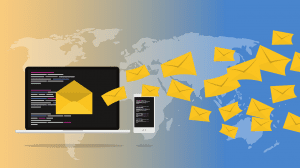What is Transactional Email and How is it Used?

Definition
“A transactional email is an automatic email sent to a single recipient to confirm a transaction or an event.”
Transactional emails have the highest opening rates because they are a direct response to a previous action; the user is somehow already waiting for them. In general, the click-through rates are incredibly high.
Transactional email is a service email that is sent after a user’s action, for example, a welcome message after registering on a website, a reset password confirmation, an auto-responder, a purchase receipt, etc.
Transactional emails are functional, and they are necessary for the normal functioning of your activity. If they are no longer sent, the function they perform ceases to be fulfilled, which can have severe consequences and cause you to lose many customers. Since transactional emails are so good for marketing, it is vital to ensure that they are delivered correctly to recipients and to trace it accurately.
Difference between email marketing and transactional email
Unlike marketing emails (newsletter type), which are sent in mass, transactional emails are sent to a specific recipient to confirm an action or notify them of an event. Typically, transactional emails include order confirmations, invoices, etc.
Types of Transactional Email
Invoices and receipts
Invoices and receipts can be integrated directly into confirmation emails but are sometimes the subject of a dedicated transactional email.
This kind of transactional email is particularly the case for:
- Services not requiring delivery tracking
- Subscriptions requiring the sending of an invoice at regular intervals
Tracking control
Your communication after a sale should not stop at the confirmation email. The various order follow-up emails have a crucial role in managing the wait.
You can send an email to notify your customers of the different stages of the order:
- Order preparation
- Shipped
- Arrival order
Order confirmation
Your customer expects the transactional email the most. It is essential if you sell products or services online.
Pledge of seriousness and confidence for your customers; it must fulfil several objectives:
- Confirm that the order has been taken into account
- Reassure the customer
- Send him all the information necessary for follow-up (order reference, access to his account, customer service contact, etc.)
- Give him an estimate of the delivery time
This email plays a vital reinsurance role, and it often happens that the user has doubts about taking into account his actions, hence the importance of confirmation emails.
For some customers, ordering online is still something unusual and sometimes anxiety-provoking: a particular order confirmation email should reassure them that you are serious.
Password reset
The password reset email allows you to configure a new password via a single link. It is one of the essential transactional emails to set up: without it, your users who have forgotten their password have no way of being able to access their account!
How to set up your transactional emails?
Transactional emails are based on the SMTP protocol and require a specialised solution to ensure constant and reliable deliverability.
Use a dedicated and reliable solution
The best option is to go through a specialised transactional email services to manage your transactional shipments, such as sendgrid transactional email.
Sendgrid indeed offers many advantages compared to transactional emails included in CMS such as Prestashop, Magento, Woocommerce:
- Real-time monitoring of performance indicators: deliverability, openings, etc.
- Ability to customise your templates
- Optimal and instant deliverability
Using the native solutions of most CMSs, you have no way of knowing if your transactional emails have arrived at their destination!
Separate your transactional mailings from your marketing campaigns
It is also essential to choose a solution that allows the routing of transactional emails to be separated from marketing emails.
Transactional emails are a vital point on your site and should not be penalised by the necessarily lower deliverability of your marketing mailings.
A problem in a marketing campaign can quickly lead to a decline in your reputation with email providers. You must, at all costs, avoid this impacting your transactional mailings.
Tips to Improve Your Transactional Emails
Finally, here are some tips to improve your transactional emails:
- Keep the email concise and very clear. The user already knows what he expects, so be synthetic.
- Send them a few seconds after the user action.
- Use the most beautiful and most uncomplicated model to encourage clicks.
- Place your contact details at the bottom of the page (footer).
- Always send from an active address, better if authenticated.
- Pay attention to the subject, and it must indicate the content of the transactional email to make it immediately recognisable in the inbox.



 Many companies do not realize the benefits of IT help desk software until they are in a reactive mode trying to fix issues with hardware and software that continue to compound.
Many companies do not realize the benefits of IT help desk software until they are in a reactive mode trying to fix issues with hardware and software that continue to compound.